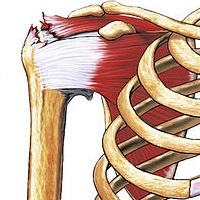
Photo from wikipedia
Measurements made on routine A–P radiographs can predict strength/quality of the proximal humerus, as shown in terms of two easy‐to‐measure parameters: Cortical index (CI) and mean‐combined cortical thickness (MCCT). Because… Click to show full abstract
Measurements made on routine A–P radiographs can predict strength/quality of the proximal humerus, as shown in terms of two easy‐to‐measure parameters: Cortical index (CI) and mean‐combined cortical thickness (MCCT). Because of high variability inherent when using established methods to measure these parameters, we describe a new orientation system. Using digitized radiographs of 33 adult proximal humeri, five observers measured anatomical reference locations in accordance with: (i) Tingart et al. (2003) method, (ii) Mather et al. (2013) method, and (iii) our new humeral head Circle‐Fit method (CFM). The Tingart and Mather methods measure CI and MCCT with respect to upper and lower edges of 20 mm tall rectangles fit to a proximal diaphyseal location where endosteal (Tingart) or periosteal (Mather) cortical margins become parallel. But high intra‐ and inter‐observer variability occurs when placing the rectangles because of uncertainty in identifying cortical parallelism. With the CFM an adjustable circle is fit to the humeral head articular surface, which reliably and easily establishes a proximal metaphyseal landmark (M1) at the surgical neck. Distal locations are then designated at successive 10 mm increments below M1, including a second metaphyseal landmark (M2) followed by diaphyseal (D) locations (D1, D2 ⋯D6). D1 corresponds most closely to the proximal edges of the rectangles used in the other methods. Results showed minimal inter‐observer variations (mean error, 1.5 ± 1.1 mm) when the CFM is used to establish diaphyseal locations for making CI and MCCT measurements when compared to each of the other methods (mean error range, 10.7 ± 5.9 to 13.3 ± 6.7 mm) (p < 0.001). © 2017 Orthopaedic Research Society. Published by Wiley Periodicals, Inc. J Orthop Res 35:2313–2322, 2017.
Journal Title: Journal of Orthopaedic Research
Year Published: 2017
Link to full text (if available)
Share on Social Media: Sign Up to like & get
recommendations!